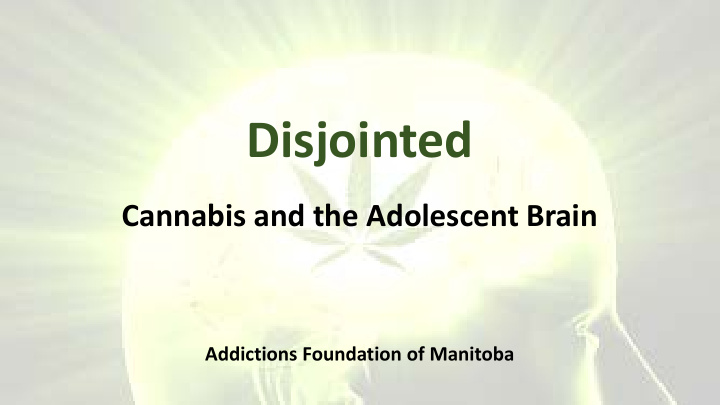



Disjointed Cannabis and the Adolescent Brain Addictions Foundation of Manitoba
Goals • Understand what cannabis is • Appreciate what the new legal status of cannabis means • Think more critically about some of the claims made about cannabis • Understand what cannabis does to teenage brains • Recognize when problems might be developing and how to limit the potential harms from using cannabis
What is cannabis?
Cannabis • AKA – marijuana, grass, weed, pot, hash, ganja, joint, dabs, shatter, budder • Cannabis products are derived from various species of the Cannabis plant. • The main active ingredient in cannabis is THC ( ∆ 9 tetrahydrocannabinol) – THC is responsible for the “high” – It has few therapeutic effects – There are hundreds of other compounds in the cannabis plant • CBD is another important component – It has no psychoactive (mind-altering) effects & might counteract some negative effects of THC – CBD may be responsible for many of the medical/therapeutic effects of cannabis
What about legal status?
Protecting Youth: Canadian Laws 2018 • No person could sell or provide cannabis to any person under the age of 19 . – Parent to their own children – Parent to children at a party at their house – Coach to team athletes – Young adults to youth < 19 years • 2 new criminal offences, with maximum penalties of 14 years in jail, for: – giving or selling cannabis to youth, and – using a youth to commit a cannabis-related offence
Protecting Youth: Advertisement Canadian Laws 2018 • The Act will also prohibit: – products that are appealing to youth (e.g., gummy bears) – packaging or labelling cannabis in a way that makes it appealing to youth – selling cannabis through self-service displays or vending machines – promoting cannabis, except in narrow circumstances where the promotion could not be seen by a young person • Penalties for violating these prohibitions include a fine up to $5 million or 3 years in jail .
How many people use it?
Past year cannabis use Manitoba & Canada, Grades 7-12 Source: Bonham A et al. (2016)
Prevalence of cannabis use in Canada: Grades 7-12, 2014-15
It’s legal so it’s safe
It is natural, so it’s harmless
Cannabis is not addictive 25% 17% 9%
What’s the big deal? I smoked it in the 70s
Trends in cannabis potency: 1960-2011 (%THC & CBD)
Cannabis users, treatment admissions & average potency: 1986-2010
No-one has ever died from a cannabis overdose?
Cannabis causes brain damage?
Prohibiting cannabis keeps kids from using it
Effects of Cannabis
Cannabis effects on brain & body
Let’s talk about brains! Language Vision & Good decisions eyesight (and bad decisions)
Wait WANT
Brains are like cities BRAINS ARE LIKE CITIES!
What are neural pathways?
The teen brain… “Under construction”
Myelination improved processing speed Pruning improved processing efficiency
The path to craving… • When we’re stressed, our brains take us down well-used pathways • Our brains are able to identify the quickest/easiest path to feeling better (like Google Maps) • When cannabis use is the quickest path, we experience this as a craving
Negative health effects
Factors Affecting Risk – Body weight & size – Age – Gender – General health & nutritional habits – Mental state (depression, anger, grief) – Tolerance – Types of product used – How often cannabis used
Signs of a Problem
Canada’s Lower Risk Cannabis Use Guidelines
So, what should we do? We need to: • Understand – how problems with Cannabis develop • Be Aware – of the potential harms of Cannabis • Seek – healthy ways to deal with stress and problems • Delay – use of Cannabis until teen brains have a chance to fully develop (21+ years old)
Questions?
Recommend
More recommend